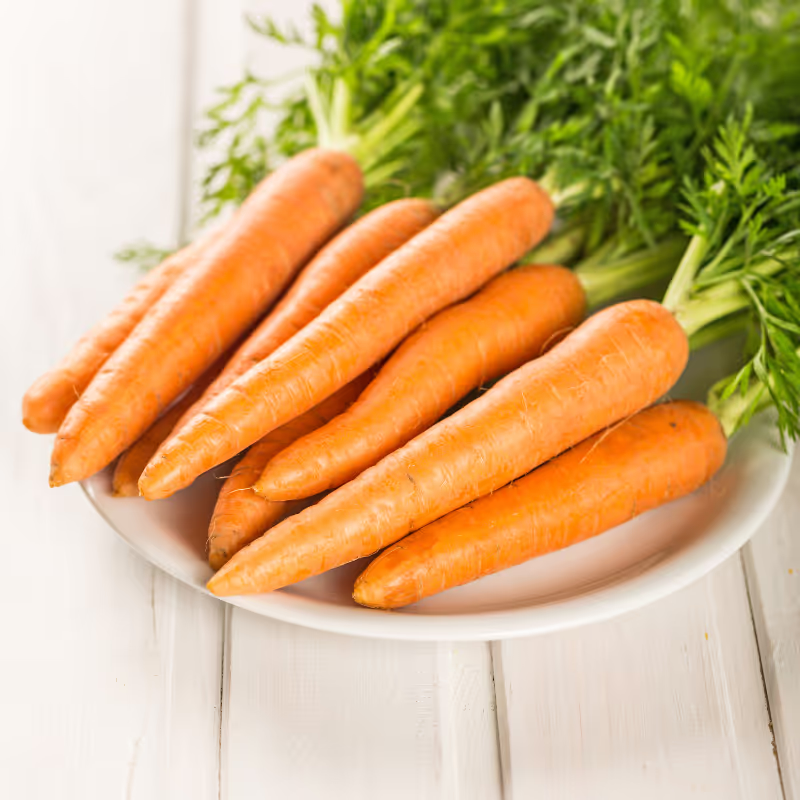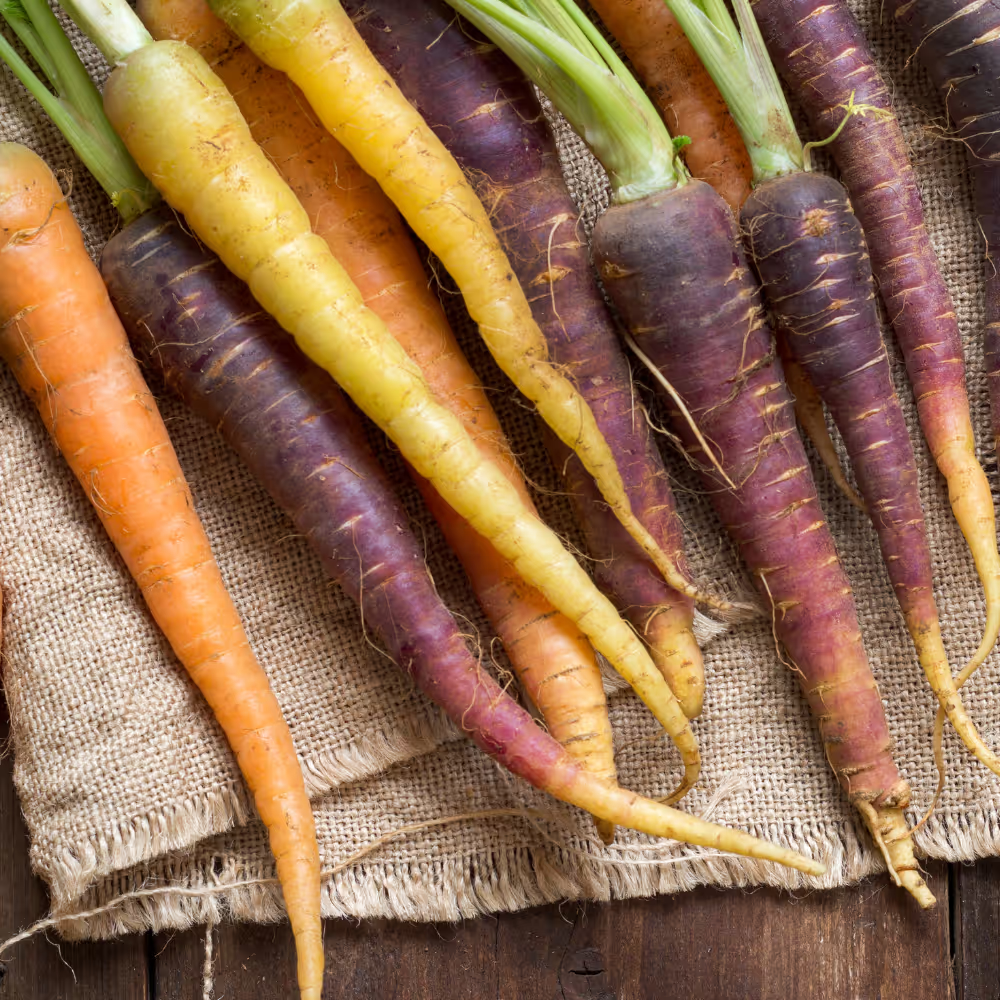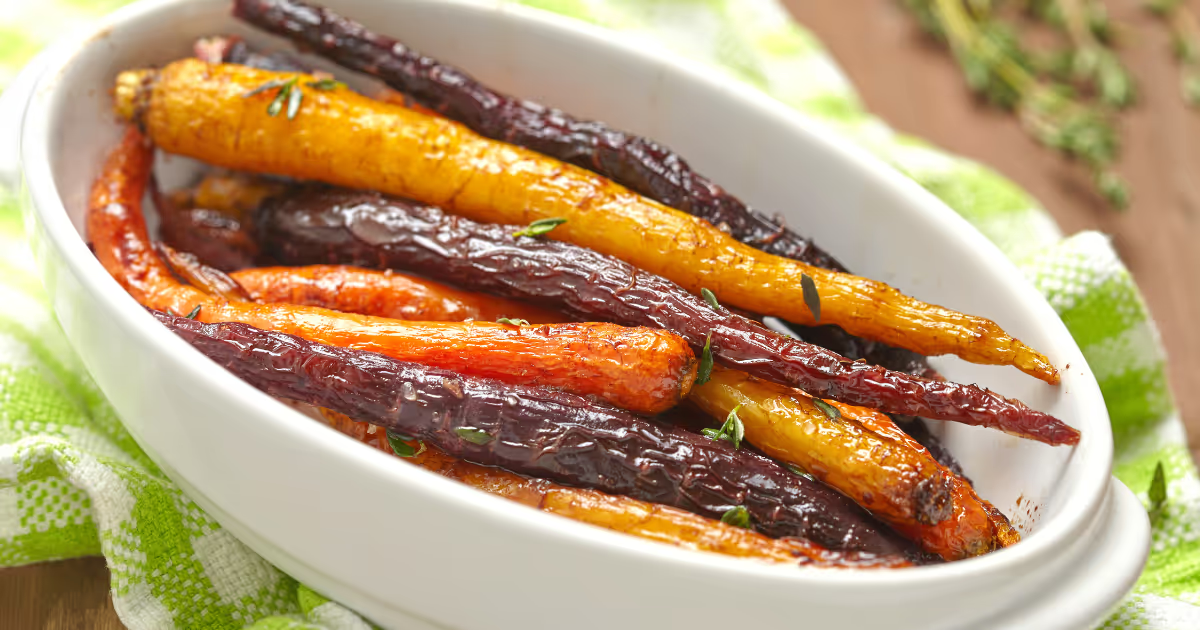What Does it Taste Like?
Carrot roots have a sweet, earthy, and slightly bitter flavor. They are crunchy when raw, and soft and tender when cooked. The sweetness of carrots depends on the variety, the growing conditions, and the cooking method. Generally, smaller and darker carrots are sweeter than larger and lighter ones.
Carrot greens have a fresh, herbaceous, and slightly peppery flavor. They are similar to parsley, but with a hint of carrot. They are tender and delicate when young, and become tougher and more bitter as they mature.
Varieties we grow

Purple Snax
Purple Snax carrots are a new variety of purple carrots that belong to the Nantes-Imperator type. They have a dazzling combination of color: purple outside and a golden interior. They are long, straight, and easy-growing, reaching 8-9 inches in length. They have a sweet and mellow flavor that makes them superb for enjoying fresh. They are crunchy and juicy, and can also be roasted, steamed, or stir-fried.

Napoli
Napoli carrots are extra-early hybrids that thrive in spring and fall. They have a cylindrical shape and a smooth, slender appearance. They are bright orange in color and have a rich sweet flavor with a hint of earthiness. They are crisp and crunchy when raw, and tender and smooth when cooked. They are ideal for slicing, dicing, or grating in salads, soups, or roasts.
Why Should I Eat It?
- Carrots are a great source of many nutrients, especially beta carotene, which is a precursor of vitamin A. Vitamin A is essential for vision, growth, and immunity. One medium carrot (61 grams) provides 509 micrograms of vitamin A, which is more than 100% of the recommended daily intake for adults.
- Carrots also provide vitamin K, fiber, potassium, and antioxidants. They may help lower cholesterol, improve eye health, and reduce the risk of cancer.
- Carrot greens are rich in minerals, such as calcium, magnesium, iron, and potassium. They also contain vitamin C, vitamin K, and chlorophyll. They may help support bone health, blood clotting, and detoxification.
Carrots

July - September
Carrots are one of the most popular and versatile vegetables in the world. They come in a variety of colors, shapes, and sizes, and can be eaten raw, cooked, or baked. But did you know that carrots are not just roots, but also greens? Yes, the leafy tops of carrots are edible, and they are delicious and nutritious too.
Recommended Storage
How Do I Store It?
Short Term
Carrots can be stored for a long using a couple of different methods. Here are some tips on how to store carrot roots and greens:
- Fridge: Remove the greens from the roots and store them separately. The greens draw moisture from the roots and cause wilting1. Wrap the roots in a damp paper towel and store them in an airtight container in the fridge. Keep them in the coolest part of the fridge, away from fruits that produce ethylene gas, such as apples. This way, they can last for up to a month.
- Cellaring: Another way to store carrots is to use sand, especially if you have a root cellar with the right conditions. You need a box or a crate, and then you do the following steps: First, put two inches of sand at the bottom of the container. Second, arrange a single layer of carrots on top of the sand. Third, cover the carrots with another inch of sand. Fourth, repeat the second and third steps until the container is full.
To store the greens, wash them and remove any stiff stems. Wrap them in a damp paper towel and store them in an airtight container in the fridge. Use them within a week.
Long Term
- Freezing: Blanch them in boiling water for a few minutes, then cool them quickly in ice water first before freezing for up to 12 months. Frozen carrots can be used in soups, stews, roasts, or side dishes.
- Pickling: Pickling carrots adds a tangy and sweet flavor, and also provides probiotics and vitamins. They can be eaten as a relish, snack, or salad ingredient.
- Canning: Canning carrots makes them shelf-stable and easy to use, but it also requires special equipment and skills, and may affect the texture and taste of the carrots. Since they're a low acid food, they can only safely be processed in a pressure canner.
- Dehydrating: Dehydrating carrots reduces their weight and volume, and concentrates their flavor and sweetness. However, dehydrating also removes some of the nutrients. Dehydrated carrots can be used in soups, stews, sauces, or snacks.
How Do I Cook It?
Carrots are a versatile vegetable that can be enjoyed in many ways, both the roots and the greens, raw or cooked.
Here are some of the best cooking methods for carrot roots:
- Raw: Carrots are crunchy and sweet when eaten raw, and they make a great snack or salad ingredient. You can peel and chop them into sticks, slices, or shreds, or use a vegetable peeler to make thin ribbons. You can also use a spiralizer to make carrot noodles, or a mandoline to make thin wafers. Raw carrots pair well with dips, dressings, cheeses, nuts, and fresh herbs.
- Steaming: Steaming is a quick and easy way to cook carrots without losing much of their nutrients, color, or flavor. You can use a steamer basket or a microwave-safe dish with a lid. Cut the carrots into even pieces and steam them until they are crisp-tender, about 5 to 10 minutes depending on the size. Season them with salt, pepper, butter, honey, or herbs.
- Roasting: Roasting is a great way to bring out the natural sweetness and caramelization of carrots. You can roast whole, halved, or sliced carrots in a single layer on a baking sheet at 425°F for 20 to 30 minutes, tossing them halfway through. Drizzle them with oil and season them with salt, pepper, and your favorite spices or herbs.
- Sautéing: Sautéing is a fast and simple way to cook carrots on the stovetop, creating a crisp and browned exterior and a tender interior. You can sauté sliced or shredded carrots in a large skillet over medium-high heat, stirring occasionally, for 10 to 15 minutes. Add some oil, butter, or broth to prevent them from sticking or burning. Season them with salt, pepper, sugar, vinegar, or soy sauce.
- Braising: Braising is a slow and low method of cooking carrots in a small amount of liquid, such as water, broth, wine, or juice. This method produces soft and flavorful carrots that absorb the liquid and the aromatics. You can braise whole, halved, or sliced carrots in a large pot or a Dutch oven over low heat, partially covered, for 30 to 45 minutes. Season them with salt, pepper, bay leaves, garlic, or onion.

And, here are some common ways that you can use carrot greens:
- Raw: Carrot greens can be eaten raw in salads, sandwiches, wraps, or smoothies. They add a nice crunch and a burst of green color to your dishes. You can also use them as a garnish or a substitute for parsley. To use them raw, make sure to wash them well and remove any tough stems. You can chop them finely or leave them whole, depending on your preference.
- Sautéed: Sautéing is a quick and easy way to cook carrot greens on the stovetop, creating a wilted and tender dish that can be seasoned with garlic, red pepper, salt, and other spices. You can sauté them in oil, butter, or broth, and serve them as a side dish or a topping for pasta, rice, or toast. To sauté them, heat some oil in a skillet over medium-high heat, and add minced garlic and red pepper flakes. Cook until fragrant, then add the carrot greens and salt, and toss to coat. Cook until wilted, about 5 to 10 minutes.
- Braised: Braising is a slow and low method of cooking carrot greens in a small amount of liquid, such as water, broth, wine, or juice. This method produces soft and flavorful carrot greens that absorb the liquid and the aromatics. You can braise them in a large pot or a Dutch oven over low heat, partially covered, for 30 to 45 minutes. Season them with salt, pepper, bay leaves, garlic, onion, or other herbs and spices.
- Sauces: Since carrot greens have a fresh, herbaceous, and slightly peppery flavor, they make a great alternative to the traditional herbs used is sauces such as pesto or chimichurri. You can replace all or part of the basil or parsley called for in either of these recipes with carrot greens.
What Goes Well With It?
Carrots pair well with a variety of flavors, both sweet and savory. Some of the best flavor pairings for carrot roots are:
- Herbs and spices: chervil, parsley, cinnamon, clove, allspice, mint, nutmeg, ginger, dill, and thyme
- Sweets and dairy: cream, cream cheese, browned butter, butter, brown sugar, maple syrup, and molasses.
- Produce: peas, garlic, potatoes, raisins, daikon, kale, spinach, Swiss chard, mushrooms, sweet potatoes, and onion3
- Savory: rice, pasta, beef, chicken, walnuts, oatmeal.
Some of the best flavor pairings for carrot greens are:
- Herbs and spices: garlic, lemon, lime, tamarind, cilantro, basil, mint, oregano, and chili.
- Sweets and dairy: honey, yogurt, cream, and cheese.
- Produce: carrots, tomatoes, cucumber, avocado, apple, and mango.
- Savory: nuts, seeds, olive oil, vinegar, and soy sauce.
